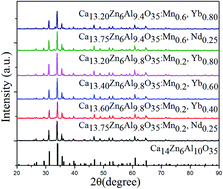Conversion of broadband UV-visible light to near infrared emission by Ca14Zn6Al10O35: Mn4+, Nd3+/Yb3+
Abstract
Efficient Ca14Zn6Al10O35: Mn4+, Nd3+/Yb3+ spectral conversion materials have been prepared by a sol–gel method. The Ca14Zn6Al10O35: Mn4+, Nd3+/Yb3+ materials can efficiently shift the short-wavelength sunlight in 250–550 nm spectral regions into near infrared emission which matches the higher sensitivity region of Si-based solar cells. The maximal energy transfer efficiency is 76.0% and 80.4% in Mn4+, Nd3+ and Mn4+, Yb3+ co-doped samples when excited at 460 nm, respectively. A dipole–dipole interaction is responsible for the energy transfer sensitization processes from Mn4+ to Nd3+/Yb3+ ions, which has been confirmed by Dexter's theory and the Yokota–Tanimoto model.


 Please wait while we load your content...
Please wait while we load your content...